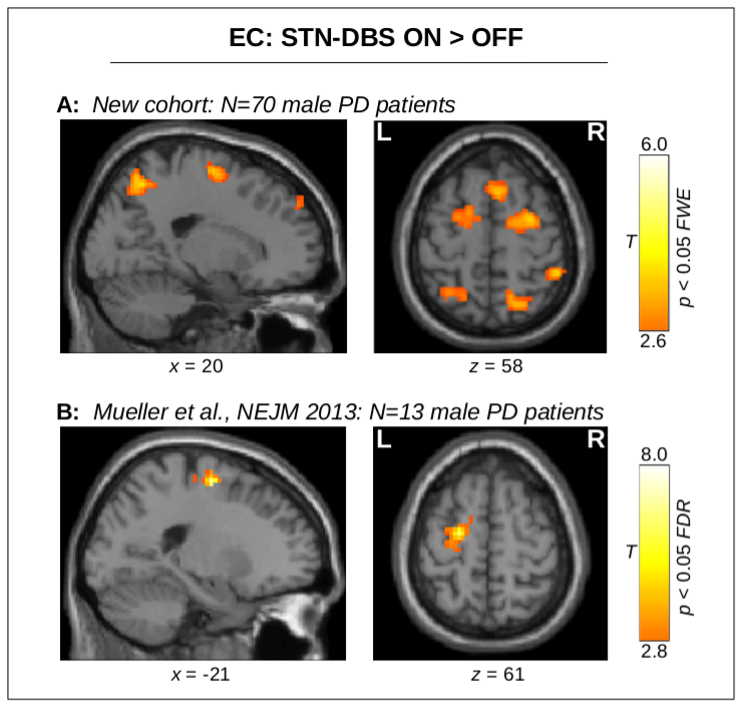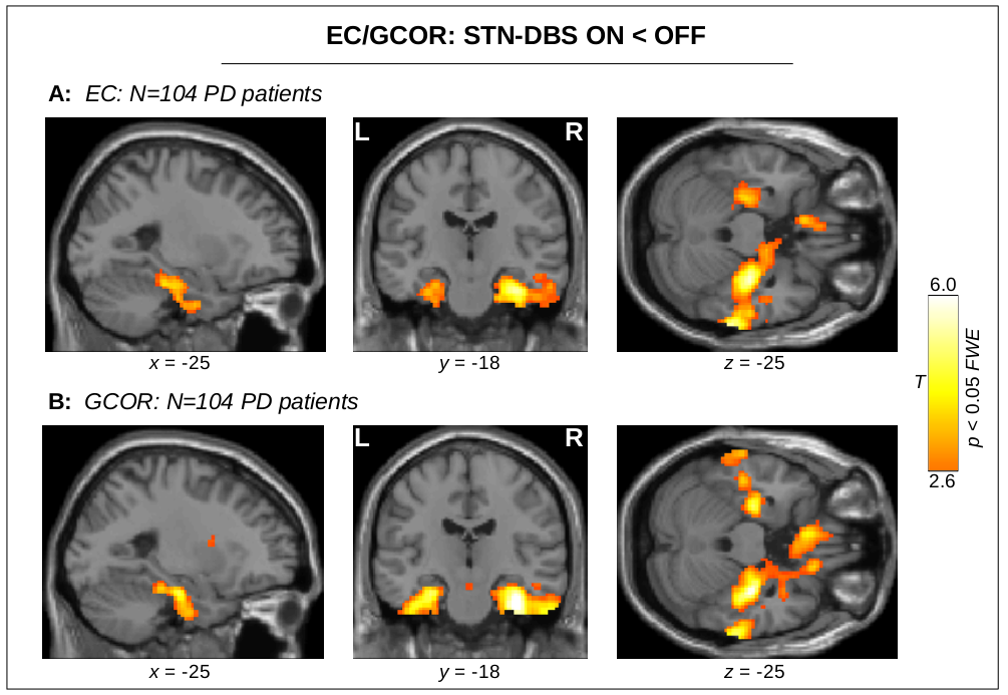Category: Parkinson's Disease: Neuroimaging
Objective: Deep-brain stimulation (DBS) became a successful method to treat Parkinson’s disease (PD), particularly with stimulating the subthalamic nucleus (STN-DBS), although the precise mechanisms mediating its efficacy remain elusive.
Background: Recent research is aimed at investigating the impact of STN-DBS onto functional brain connectivity using functional magnetic resonance imaging (fMRI), however, results are differential that might be related to sample size (1, 2). Therefore, we investigated STN-DBS-related brain connectivity alterations within a relatively large group of PD patients.
Method: The study included 104 patients with advanced PD (34 fem, age 59.5±7.9 years, disease duration 15.1±6.3 years). Clinical assessment and functional MRI was performed in two sessions in the STN-DBS ON and OFF state. For each participant and each session, brain network centrality was computed using eigenvector centrality (EC) and global correlation (GCOR) with the LIPSIA software and the CONN toolbox, respectively. Thereafter, all EC and GCOR maps were fed into a group analysis using SPM12 with a flexible factorial model including the factors SUBJECT, GENDER, and STN-DBS. In particular, we tested for significant STN-DBS ON-OFF differences using family-wise error correction at cluster-level with p<0.05.
Results: We replicated our previous finding showing an STN-DBS-related significant EC increase in various cortical brain regions including in the left and right premotor cortex in 70 male PD patients (Fig 1A). Using the inverse contrast, we found an STN-DBS-related significant EC and GCOR decrease across the whole group of 104 PD patients in the left and right entorhinal cortex (Fig 2).
Conclusion: Our fMRI study replicated a previous finding showing an EC increase with STN-DBS in the premotor cortex in male PD patients (1). We did not find any centrality decrease in the motor cortex as reported in Zhang (2), neither with EC nor with GCOR, however, we found a major centrality decrease in the left and right entorhinal cortex suggesting a relationship between STN-DBS and hippocampal connectivity in PD (3).
Supported by a grant of the National Institute for Neurological Research, Czech Republic, Programme EXCELES (ID project No. LX22NPO5107) and the Charles University: Cooperatio Program in Neuroscience.
References: 1. Mueller K, Jech R, Schroeter ML. Deep-brain stimulation for Parkinson’s disease. N Engl J Med. 2013 Jan 31;368(5):482-3.
2. Zhang C, Lai Y, Li J, He N, Liu Y, Li Y, Li H, Wei H, Yan F, Horn A, Li D, Sun B. Subthalamic and Pallidal Stimulations in Patients with Parkinson’s Disease: Common and Dissociable Connections. Ann Neurol. 2021 Oct;90(4):670-682.
3. Aybek S, Lazeyras F, Gronchi-Perrin A, Burkhard PR, Villemure JG, Vingerhoets FJ. Hippocampal atrophy predicts conversion to dementia after STN-DBS in Parkinson’s disease. Parkinsonism Relat Disord. 2009 Aug;15(7):521-4.
To cite this abstract in AMA style:
R. Jech, F. Ruzicka, D. Kiakou, A. Lasica, P. Filip, K. Burdova, D. Urgosik, K. Mueller. Deep brain stimulation impacts functional brain connectivity in Parkinson’s disease. [abstract]. Mov Disord. 2023; 38 (suppl 1). https://www.mdsabstracts.org/abstract/deep-brain-stimulation-impacts-functional-brain-connectivity-in-parkinsons-disease/. Accessed January 6, 2026.« Back to 2023 International Congress
MDS Abstracts - https://www.mdsabstracts.org/abstract/deep-brain-stimulation-impacts-functional-brain-connectivity-in-parkinsons-disease/


